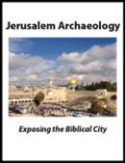
Research Director, Kfir Arbiv, cleans ballista stones uncovered at an archaeological site in Jerusalem. Courtesy Israel Antiquities Authority.
Historians and archaeologists alike are fascinated with the events surrounding the First Jewish Revolt, which culminated with the Roman general Titus storming Jerusalem and sacking the Second Temple in 70 C.E. Now, Kfir Arbiv, a researcher with the Israel Antiquities Authority (IAA), is taking a closer look at this battle. Utilizing computer modeling, Arbiv examined destruction and attack patterns to reach a deeper understanding of the events that preceded the Temple’s destruction.

Past excavations throughout the city yielded spears, swords, and arrowheads from the siege. Of particular interest to Arbiv, however, were hundreds of recovered ballista stones. Arbiv studied ancient throwing machines and catapults found at a nearby Roman arsenal and compared their ranges to the find spots of the ballista stones that rained down on Jerusalem in the first century. Key among Arbiv’s findings was the intense concentration of ballista stones against one defensive wall, which confirms Josephus’s account of the battle in The Jewish War.
From Dig to Desktop
How does an archaeologist use a few rocks to recreate an entire battle? Aided by advanced computer software, Arbiv synthesized a wealth of archaeological and geological data to reimagine the four-month-long siege of Jerusalem. Many field archaeologists use GIS (Geographic Information Systems) to catalog the precise locations of newly discovered artifacts. Arbiv took this technology one step further.
In addition to tracking the place of impact, Arbiv traced the origin of the blow, analyzing the size of the ballista stones and tying each to a Roman weapon that could have propelled it through the air. Roman arsenals included a variety of weapons, such as bolt-throwing machines with estimated ranges of 300–1,300 feet, as well as catapults with ranges of 500–650 feet. Smaller projectiles were thrown by trained infantrymen using slings. Arbiv also considered the height of the city’s first-century walls, as well as the topography of the surrounding region, as differences in elevation would have affected the trajectory of the missiles.

The excavation site, illustrating the distribution of the ballista stones in situ. Courtesy Israel Antiquities Authority.
From his research, Arbiv drew significant conclusions. The study revealed the density of Roman attacks on the city’s so-called Third Wall. Moreover, Arbiv theorizes that some of the Roman artillery machines were set up in Nahalat Hashiva, a central area in modern Jerusalem, often called “Cat’s Square.” Both discoveries contribute much to the ongoing study of the destruction of the Jerusalem Temple. Eli Eskosido, Director of the IAA, remarked, “The use of up-to-date research methods reveals more and more about the fascinating history of Jerusalem.” With ever-evolving technologies, archaeologists continue to push the envelope of what we might uncover about the ancient world.
Read more in the Bible History Daily:
The Third Wall of Jerusalem: Where Romans and Jews Battled
Jerusalem Tunnel Provides Glimpse of Jewish Revolt
Ophel Excavations Uncover Jewish Revolt Coins in Rebel Hideout
All-Access members, read more in the BAS Library:
“Revolt” Coins Minted on Temple Mount
Roman Coins Boast “Judaea Capta”
Recovering Roman Jerusalem—The Entryway Beneath Damascus Gate
Not a BAS Library or All-Access Member yet? Join today.The post Modeling the Fall of the Second Temple appeared first on Biblical Archaeology Society.


0 Commentaires